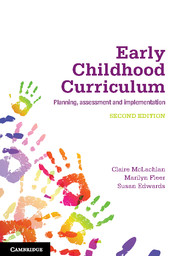Book contents
- Frontmatter
- Contents
- About the authors
- Acknowledgements
- 1 Introduction
- 2 Theory, research and the early childhood curriculum
- 3 Development and learning – how views of development shape how curriculum is framed
- 4 Curriculum as a cultural broker
- 5 Interpreting early childhood curriculum
- 6 Cultural-historical curriculum in action
- 7 Curriculum as a conceptual tool: Observation, content and programming
- 8 Assessing children and evaluating curriculum
- 9 Content knowledge: The sciences, maths and numeracy
- 10 Content knowledge: Language, literacy and ICT
- 11 Content knowledge: The arts and health, wellbeing and physical activity
- 12 Conclusions
- Glossary
- References
- Index
11 - Content knowledge: The arts and health, wellbeing and physical activity
- Frontmatter
- Contents
- About the authors
- Acknowledgements
- 1 Introduction
- 2 Theory, research and the early childhood curriculum
- 3 Development and learning – how views of development shape how curriculum is framed
- 4 Curriculum as a cultural broker
- 5 Interpreting early childhood curriculum
- 6 Cultural-historical curriculum in action
- 7 Curriculum as a conceptual tool: Observation, content and programming
- 8 Assessing children and evaluating curriculum
- 9 Content knowledge: The sciences, maths and numeracy
- 10 Content knowledge: Language, literacy and ICT
- 11 Content knowledge: The arts and health, wellbeing and physical activity
- 12 Conclusions
- Glossary
- References
- Index
Summary
Learning intentions
In this chapter we will examine:
current research on the content knowledge that teachers need to have about the arts, health, wellbeing and physical education in early childhood
how teachers can build on children’s home experiences in the early childhood classroom to help transform children’s thinking.
In this chapter the theory and the practice of Vygotsky’s (1998) work on concept formation will be further discussed. The content areas of arts and health, wellbeing and physical education will be used to illustrate the importance of conceptual knowledge in the early childhood curriculum. How to integrate domain knowledge into curriculum was identified by students in our opening scenario:
Jacob: I guess that’s part of the curriculum design stuff, isn’t it? That you work out what it is that you want children to be able to do and therefore you plan activities and work out in advance what you think they will achieve, so that you can assess if it worked or not.
Arohia: But how does that fit with all these ideas around co-construction that our practicum lecturer has been talking about? How can I plan in advance, if I am trying to work with children to plan the curriculum?
On the face of it, the topics in this chapter sound like an unusual combination, but as we hope this chapter shows, much of the concept formation associated with these domains of knowledge involves the interrelationship of cognitive abilities and psychomotor skills. For the purposes of simplicity only, the arts in this discussion include the visual arts, dance and music. The focus is on concept formation that involves developing physical abilities, such as drawing, painting, playing a musical instrument, singing, dancing, and playing on the jungle gym, playing ball games and other games with rules.
- Type
- Chapter
- Information
- Early Childhood CurriculumPlanning, Assessment, and Implementation, pp. 182 - 196Publisher: Cambridge University PressPrint publication year: 2013



